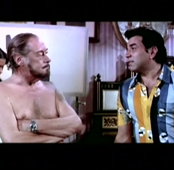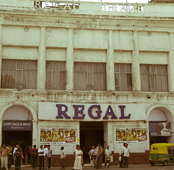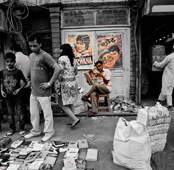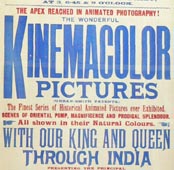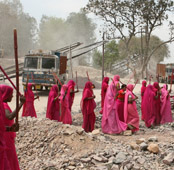THE STATE OF SMALL THINGS
The Indian face for state support to the movies is the National
Film Development Corporation (NFDC). Its mission statement says
that it “aims at fostering excellence in cinema and promoting the
diversity of its culture by supporting and encouraging films made
in various Indian languages”.
Instituted in 1975, and run by the Ministry of Information &
Broadcasting (I&B) the NFDC got into producing movies only in
the eighties (state funded films before this were produced by the Film Finance Corporation or the FFC). And did some sterling work. It co-produced Gandhi
and produced films like Kundan Shah’s Jaane Bhi Do Yaaron,
Ketan Mehta’s Bhavni Bhavai and Mirch Masala, Govind Nihalani’s
Party, Saeed Mirza’s Naseem and Saleem Langde Pe Mat Ro and most
of Mani Kaul’s films. The government would subsidize the NFDC
hugely by the fee it charged on the import and export of films. But
this revenue stream dwindled, with liberalization in the 1990s,
and the downslide began. The NFDC resorted to broadcasting its films
on Doordarshan for advertising revenues – but even these dried
up by 2002-03 with advertisers switching to satellite TV. A profit
making PSU (Public Sector Unit) till then, this was the year the
NFDC turned sick. It managed to stay afloat only by means of a
government loan of Rs 19.77 crores. By 2005 there was talk of
shutting the NFDC down. Filmmakers claimed the company’s failure
lay in its inability to distribute and exhibit its films. On paper the NFDC had initiated a scheme of theatre building around the country, but it never took off. With the state, as with independent filmmakers, distribution is a Rubik’s cube that is still to be set
right.
On 16 September 2010 the government infused fresh equity of
Rs 32.4 crores into the company. Rs 19.77 crores of this amount
was the writing off of the loan the government had granted the
corporation, by converting it into equity. Rs 8.63 crores was a
similar conversion of interest due on this loan.
Nina Lath Gupta has been the Managing Director of the NFDC
since 2006. An ex IRS officer, one of the first things she did to
spearhead the company’s resurrection, was to institute the NFDC’s
Film Bazaar. The film market held annually, just after the
International Film Festival of India (IFFI) in Goa, comprises labs
which enable members of the Indian film industry to interact
with experts from around the world on subjects ranging from
production, screenwriting, direction, editing to the marketing and
distribution of their films. Scripts are worked on, films in a work-
in-progress stage are improved, and marketing and distribution
plans are developed. Guneet Monga, who’s been to the Film
Bazaar three years in a row now, claims to have done “serious
business” there. She has placed AKFPL scripts in the workshops
and been a part of the production lab herself.
Gupta works from within a glass walled cabin at the NFDC office
in Nehru Centre, Worli, Mumbai. A diminutive lady, she seems
somewhat dwarfed by the huge desk she sits at, but you forget
this as she begins to speak. Media savvy and quick with her
replies Gupta makes it a point to smile formally after every retort,
as if meaning to ease its sinking in.
The NFDC has commissioned 23 productions across 12 Indian
languages in the last five years. Among these are Anurag
Kashyap’s That Girl In Yellow Boots and Dibakar Banerjee’s
Shanghai. It has been criticized for backing these films, because
they were made by established filmmakers who aren’t really seen
as being in need of the NFDC’s aid. Gupta says that the NFDC co-
produced these films because “they applied”. “It is not as if we
only worked with new talent in the past either,” she says. She
cites Ketan Mehta’s Mirch Masala, Sudhir Mishra’s Dharavi and
Mani Kaul’s films. Neither of these were first films.
NFDC has a script selection committee that comprises members
of the film fraternity. They’re the ones who shortlist the films
NFDC must back. Vikramjit Roy, General Manager (Production) at NFDC says “we don’t give out names of our (the script selection committee’s) members”. He doesn’t have a clear answer on why. All he says is they’re “a good mix of people from the field of arts and culture who have a love and understanding of cinema”. “It’s not a state secret, but we would like to keep it confidential,” he says. “There’s a certain dignity which comes with the job and we would like to maintain that.”
The shortlist made by the script selection committee finally
goes to the board of directors at the NFDC who take the final call.
The board, appointed by the Information & Broadcasting (I&B) ministry comprises six people currently. The “Part-time Chairman”, according to the NFDC
website, is veteran filmmaker Ramesh Sippy, who took over from
actor Om Puri in January this year. Then there is Gupta. And
Director (Finance) Sahab Narain, who has a history of working
with Public Sector Units (PSUs). Another director is D P Reddy,
an IAS officer who is Joint Secretary (Films) at the I&B Ministry.
Finally there are two gentlemen who occupy positions
of “Non-official Part-time Director”, who have also been appointed
this January, along with Sippy . They are adman and (non-film)
music composer Jawahar Lal Wattal, who is also a Padma Shri
awardee. And cinematographer A K Bir.
When asked if there is a difference in the kind of films NFDC
backed in the 70s and 80s and the kind it backs now, Roy simply
says, “I believe cinema was as good then as it is
now”. He then goes on to list out the general criteria the
NFDC keeps in mind: “It should be a good story; something that
pushes the creative envelope; that goes out and creates an impact
in international markets; and the films should reflect the diversity
in Indian culture; and showcasing promising talent.”
NFDC’s production policy guidelines lay down clearly that it will
finance an entire film only if it is a filmmaker’s first feature.
In the last five years the company has produced 13 such firsts.
Among these is Gurvinder Singh’s Punjabi film Anhey Ghorhey
Da Daan: a heart wrenching tale, masterfully told, about a
day in the life of a farmer and his family who are caught in
the middle of circumstances that are beyond their control or
comprehension. The film has won National awards for direction
and cinematography and the $ 50,000 Black Pearl Trophy at the
Abu Dhabi International Film Festival. It is also one of the only
5 of the 13 that has seen a theatrical release. The other 4 are Laxmikant
Shetgaonkar’s Konkani film Paltadacho Munis (completed in 2009, released in two Goan theaters in 2010), K. M. Madhusudanan’s Bioscope in Malayalam, Joydeep Ghosh’s Bengali film Mayabazaar (made in 2009, released in 2012) and Bidyut Kotoky’s bi-lingual (Assamese and Hindi) film Ekhon Nedekha Nodir Xipare (made in 2009 and released in 2012 after, among other happenings, the Minister for Development of the North Eastern Region Bijoy Krishna Handique wrote a letter to I&B minister Ambika Soni requesting it be released).
Other filmmakers have been anxious about when the NFDC might be able to
release their films in the theaters. Aijaz Ahmed, for instance, is director of the Hindi
film White Elephant which still hasn’t seen a release though it was completed two and a half years ago. “For NFDC to be as good a platform for the independent filmmaker as it is made out to be,” he says. “It has to be able to release its films.” He had said in 2011 to Mumbai Mirror: “(The NFDC) say NDTV was supposed to release the film in India, while NFDC was looking at selling it overseas. But NDTV has withdrawn from the project.”
Partly, the reason for NFDC landing in this soup again (the failure
to market their content was what had set them back even a
decade ago) is that they’ve co-produced these films with partners
(such as an equal partnership with NDTV for four films) who were
supposed to handle the distribution and marketing of the films,
and didn’t. “These collaborations were way beyond our control,”
says Gupta. “I won’t comment on the deals.” When asked to
clarify whether she means the decision of who to collaborate with
was beyond their control or the execution of the deals, Gupta
simply repeats: “I won’t comment on the deals.”
But Gupta does admit that “Distribution has been a critical failure
in NFDC from its inception. During the restructuring we had
to build up many skill sets and one skill set we never had, and
we needed to build up is distribution.” Gupta clarifies that by
distribution she means a whole gamut of activities: theatrical
releases, TV rights, home video labels, VOD platforms, overseas
sales. She doesn’t see the sense of having “a 100 screen release
in empty theaters”.
“We’re still recovering from 30 crores of loss in the last decade,”
says Gupta. “We can’t burn ourselves out on the theatrical release
of one film.” Besides, says Gupta, “a theatrical release shouldn’t
be the benchmark for distribution.” She points out that both Jaane
Bhi Do Yaaro and Gandhi were commercial failures in India at
the time of their release.
Instead, the money-spinning potential of NFDC films lie in their
shelf life. “An Anhey Ghodey… will not be burnt and die in three
weeks of theatrical release,” says Gupta. “It will be watched
even after twenty years.” Which is possibly why it takes pride of
place in NFDC’s recently launched DVD series called Cinemas Of
India. This series will be used to distribute new films produced by the NFDC as well as older classics. More than 79 older films have been restored. 30 have been released. Writes film critic Jai Arjun Singh in The Caravan: “For the Indian film buff who
believes that aesthetic pleasure is vital to the movie-watching
process (even when the movies themselves are “serious”) and
who has been exposed to brilliant prints of international classics,
these restorations are a first step in what will hopefully be a more
rigorous approach to preserving our filmic past.” Refusing to
comment on the actual sales figures of these DVDs, all Roy says is
that “they’re selling like hot cakes.”
Yet there is no denying that the movie theatre is the ultimate
bastion for any film. Even Gupta, whose answers are peppered
with phrases like “measured decisions” and “the last mile”, is
invested in the idea of a chain of specialty theaters that the NFDC
has tried to put in place for decades, in vain. “The difference
(between other countries that do have these and India) is that
India is a vast, diverse country,” says Gupta. “To build one or two
would be only a drop in the ocean.” She says she cannot “commit
to a timespan” for these theaters because a “huge capital
investment” will be needed for them. She cites the losses that
have been carried forward from the last decade again.
Truth is, setting up these theaters might be too mammoth a
project for the NFDC. But considering exhibition, more than
production, is the prime obstacle for the indie filmmaker today,
perhaps the I&B ministry should consider building the promised
theaters as a separate initiative.
And if the initiation of a theatre building project is too challenging,
the least the I&B ministry could try and arrange is tax exemptions
and subsidies to exhibitors who show Indian independent films
that are below a certain budget. Countries like France and the
USA are known for the tax breaks it gives to those who invest
in the movies. France, which used to contribute significantly to
funding cinema has now, post the recession, chosen to continue
this support by implementing a lucrative tax scheme for wealthy
individuals who want to invest in the industry.
“We are charged a 12 % service tax,” says AKFPL Producer Guneet Monga. “The bigger players may not be affected by this but at least those who produce their films for
less than Rs 5 crores should be given an exemption or tax cut?”
Then there is the issue of entertainment tax that is levied on the
ticket sales by the state governments. As a result entertainment
tax in India could vary drastically. It could range from 25% (on the net ticket price) in Goa, for instance to 40% in UP and Maharashtra. “Indian filmmakers are complaining about the high rate of entertainment tax,” said the I&B minister Ambika Soni at IFFI last year. “The Central government is trying to bring entertainment tax under the Goods & Services Tax (GST).” But the GST, a unified tax code for the centre and states, is still a long way off. Till it arrives, some states enact vague, often parochial criteria for an exemption from entertainment tax. Tamil Nadu,for instance, exempts all movies that are in Tamil, provided there is “no overdose of violence, adult content, obscenity… “. Similarly in Maharashtra Marathi movies receive an exemption. Yet we rarely get to hear of exemption specifically for low budget movies. Or for films that have won awards or are of a certain quality, or which address relevant issues – especially when such films don’t have stars in them.
These exemptions could also be made up of smaller measures.
For instance, the Central Board Of Film Certification charges the
producer for renting the hall that a film will be seen in as well
as Rs 20,000 (Rs 10,000 for regional films) as a ‘cess fee’ to the Government. For
Sunderrajan who made The Untitled Kartik Krishnan Project the
latter amount came to nearly half the cost of his film.
Keeping Up With The Indie Joneses
ArticleSeptember 2012
 By Rishi Majumder
By Rishi Majumder
Rishi Majumder is Senior Editor at The Big Indian Picture.


